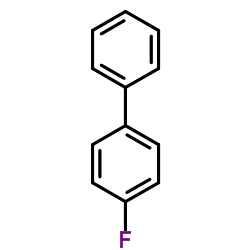4-Fluorobiphenyl

4-Fluorobiphenyl structure
|
Common Name | 4-Fluorobiphenyl | ||
|---|---|---|---|---|
| CAS Number | 324-74-3 | Molecular Weight | 172.198 | |
| Density | 1.1±0.1 g/cm3 | Boiling Point | 253.0±0.0 °C at 760 mmHg | |
| Molecular Formula | C12H9F | Melting Point | 75-79 °C(lit.) | |
| MSDS | USA | Flash Point | 95.8±5.9 °C | |
|
Update on biological actions of 1alpha,25(OH)2-vitamin D3 (rapid effects) and 24R,25(OH)2-vitamin D3.
Biochem. Pharmacol. 31(10) , 1849-56, (1982) All biologic responses to vitamin D are now known to arise as a consequence of the metabolism of this seco-steroid into its two principal biologically active metabolites 1alpha,25(OH)(2)-vitamin D(3) (1ALPHA;,25(OH)(2)D(3)) and 24R,25(OH)(2)-vitamin D(3) (24R... |
|
|
Metabolism of 4-fluoroaniline and 4-fluorobiphenyl in the earthworm Eisenia veneta characterized by high-resolution NMR spectroscopy with directly coupled HPLC-NMR and HPLC-MS.
Xenobiotica 32(6) , 479-90, (2002) 1. Little is known about metabolism of xenobiotics by earthworms, despite their importance in soil ecotoxicity testing. Normal earthworms and earthworms treated with antibiotics to ensure inhibition of gut microflora were exposed to two model xenobiotic compo... |
|
|
Biotransformation of fluorobiphenyl by Cunninghamella elegans.
Appl. Microbiol. Biotechnol. 86(1) , 345-51, (2010) The fungus Cunninghamella elegans is a useful model of human catabolism of xenobiotics. In this paper, the biotransformation of fluorinated biphenyls by C. elegans was investigated by analysis of the culture supernatants with a variety of analytical technique... |
|
|
Anaerobic degradation of the aromatic hydrocarbon biphenyl by a sulfate-reducing enrichment culture.
FEMS Microbiol. Ecol. 68(1) , 86-93, (2009) The aromatic hydrocarbon biphenyl is a widely distributed environmental pollutant. Whereas the aerobic degradation of biphenyl has been extensively studied, knowledge of the anaerobic biphenyl-oxidizing bacteria and their biochemical degradation pathway is sc... |
|
|
The application of 19F nuclear magnetic resonance to investigate microbial biotransformations of organofluorine compounds.
OMICS 11(3) , 314-24, (2007) Fluorinated organic compounds, although rare in nature, are significant environmental contaminants owing to the numerous applications for which this class of compounds is employed. It is important that biodegradation of these compounds can be readily assessed... |
|
|
Degradation of 4-fluorobiphenyl in soil investigated by 19F NMR spectroscopy and 14C radiolabelling analysis.
Chemosphere 38(5) , 1085-101, (1999) The incubation of the model pollutant [U-14C]'-4-fluorobiphenyl (4FBP) in soil, in the presence and absence of biphenyl (a co-substrate), was carried out in order to study the qualitative disposition and fate of the compound using 14C-HPLC and 19F NMR spectro... |
|
|
Degradation of 4-fluorobiphenyl by mycorrhizal fungi as determined by (19)F nuclear magnetic resonance spectroscopy and (14)C radiolabelling analysis.
Appl. Environ. Microbiol. 65(9) , 4021-7, (1999) The pathways of biotransformation of 4-fluorobiphenyl (4FBP) by the ectomycorrhizal fungus Tylospora fibrilosa and several other mycorrhizal fungi were investigated by using (19)F nuclear magnetic resonance (NMR) spectroscopy in combination with (14)C radiois... |